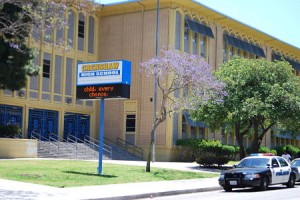Participants in Reporter Corps, a USC Annenberg program to train young adults from South LA to report on their own communities, created audiovisual introductions to their neighborhoods this summer. Ryan Johnson takes us to where she grew up, Baldwin Hills, and talks with residents about problems with schools, diversity, and transportation challenges.
Ryan Johnson, 19, Immaculate Heart graduate, Loyola Marymount University student
Three generations of my family have lived in South Los Angeles, and I have lived in the Baldwin Hills section my entire life. Although that area of South L.A. has gained the reputation of being a predominantly middle-class, African-American neighborhood and is often referred to as “the black Beverly Hills,” that is not the whole story. Not all of Baldwin Hills is wealthy, and the media neglects covering the poverty and lack of resources that also exist. While living in my neighborhood, I have always felt that I needed to travel to other parts of L.A. to gain better resources, an education, and entertainment. Unfortunately, my neighborhood has never felt safe enough to walk to various places in comparison to other regions of L.A. I have attended school both in my immediate community as well as in the greater Los Angeles area. As a result of the positive and negative experiences I’ve had in my neighborhood, I have always been interested in learning the ways in which I can give back and improve conditions in the southern Los Angeles region. I am a sociology major at Loyola Marymount University and I had the privilege of taking a community organizing course this past semester.















